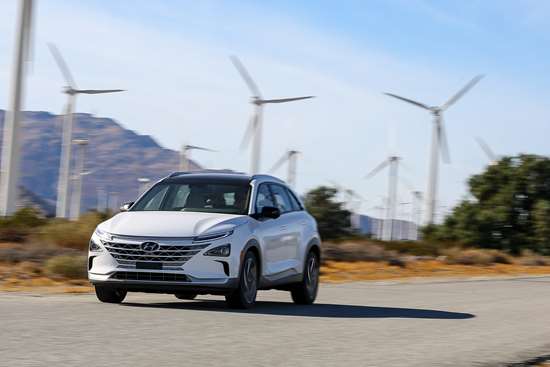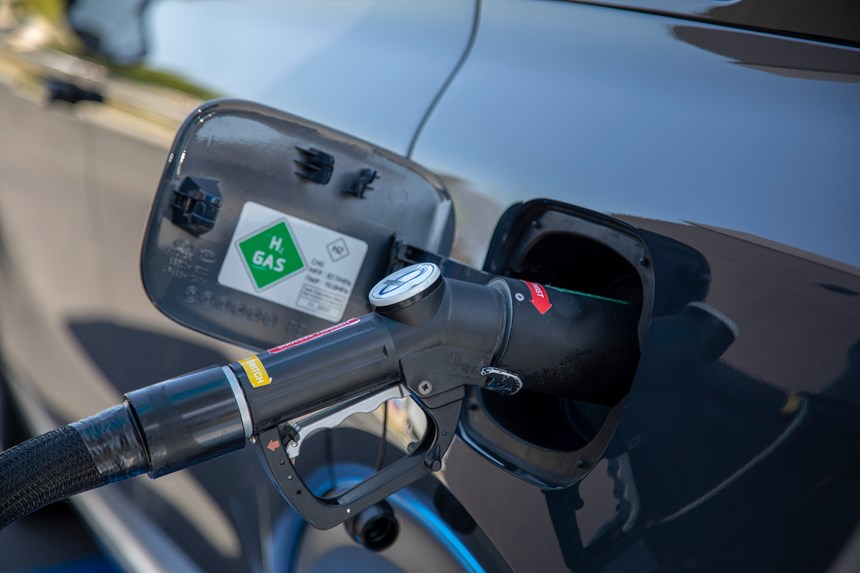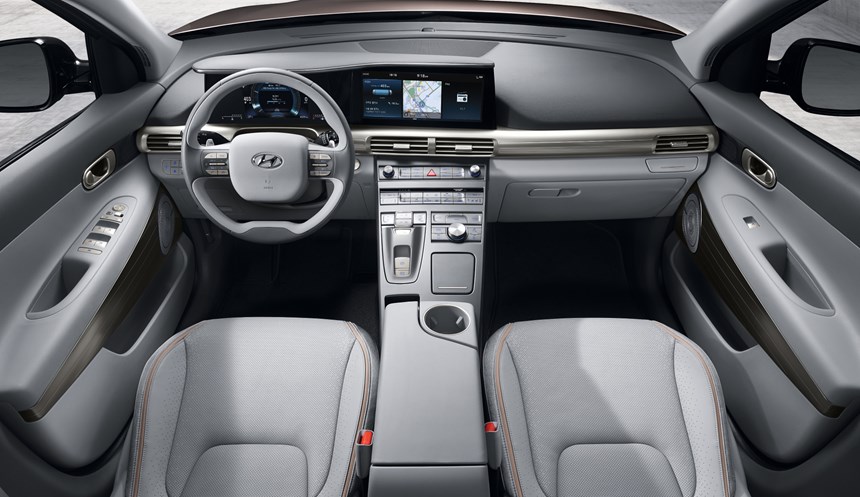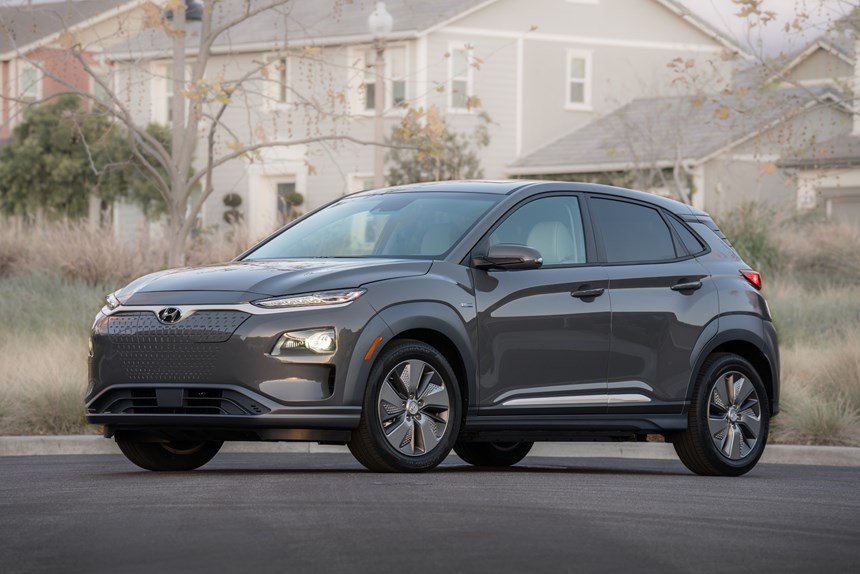What’s Nexo?
Hyundai has developed a hydrogen-powered vehicle that has the capability and the stylishness that might make people wonder why there aren’t more hydrogen stations.
#hybrid
“We believe in fuel cell electric vehicles,” says Dr. Bo Ki Hong, Fuel Cell Research Fellow, R&D Div., Hyundai Motor Company. Which is arguably something of an understatement, at least in the context of what the company has been doing since 1998, when it began its development of fuel cells. By 2004 the company had developed a fuel cell stack, followed in 2005 with the development of a fuel cell system, a fuel cell electric vehicle (FCEV) powertrain by 2007, and then in 2013, launched a FCEV Tucson on the world market, with the first vehicle going to Copenhagen (which must be kept in mind, as the objective than Hyundai has is to provide FCEVs on a global basis). What they argue is the first “commercialized mass-produced FCEV,” manufactured on a line in the company’s Ulsan plant, came to the U.S. in 2014. While the penetration in the U.S. market vis-à-vis the Tucson with a 2.0-liter engine has been minimal at most, Mike O’Brien, vice president, Product, Corporate & Digital Planning, Hyundai Motor America, points out that in California, which represents about 80 percent of all FCEV sales (keep in mind that there are also the Honda Clarity and Toyota Mirai on the U.S. market), there are, as of October 2018, 35 retail hydrogen stations in the entire state. Know that California measures 163,696 mi² and has a population of nearly 40-million people. Thirty-five retail hydrogen gas stations. O’Brien says that five more are commissioned so that there should be 40 by the end of 2018. Nineteen are expected to be built next year. So by the start of 2020 there will be 59 stations in the state that has the greatest penetration of FCEVs (and there is this comparative data point: According to the California Energy Commission there were an estimated 10,353 gasoline stations in the state in 2017.) O’Brien says that they like to deliver FCEVs in areas where there is access to two or three fuel stations (in case there is a pump failure or a lineup of vehicles, with presumably the former being more likely than the latter).
All of which is prelude to the 2019 Hyundai Nexo, a purpose-built FCEV, a mass-produced vehicle that is destined for global markets. At the time the vehicle is introduced in the U.S., it is available on the South Korean market, and the demand is outstripping supply, says O’Brien, who believes that the Nexo will also have solid sales in Europe, because of the build-out of infrastructure (i.e., fueling stations) being supported by governments there.
The Tucson fuel cell vehicle gave the company experience. The plan for the Nexo is to give it volume.
Were it not for the still-limited number of hydrogen fueling stations, the Nexo could become a daily driver for any number of people for the simple reason that the vehicle is engineered so that it is essentially like a gasoline-powered vehicle. Its motor produces 161 hp and 291 lb-ft of torque. It has a range of 380 miles. The crossover styling with the hatch in the back provides 29.6-ft3 of cargo capacity. The Nexo can be refueled in five minutes or less.
Briefly, the fuel cell operates by passing hydrogen molecules through an anode; the electrons are stripped and the atoms are ionized, or carry a positive charge; the electrons flow through a circuit to do work (power the motor) and eventually join the ions at the cathode where oxygen is plumbed in: the result is that the electrons and the protons are recombined with each other and then that’s joined with the oxygen, resulting in the exhaust, which is water. Each fuel cell produces a limited amount of electricity, so for vehicles, there is a series of cells that are connected: they are “stacked,” which is why you hear the term “fuel cell stack.” It is also worth noting that platinum is used as a catalyst in fuel cells, which means that just the raw material is fundamentally expensive, to say nothing of the costs driven by the complexity in manufacturing the fuel cell. According to Dr. Hong Hyundai personnel performed in-house development of both the membrane electrode assembly (this is what performs the ionization) and the metallic bipolar plate used in the stack.
In the Nexo, the 120-kW (161-hp) traction motor and the fuel cell stack are integrated to improve packaging compared with the setup in the Tucson FCEV. Another of the fundamental changes for the Nexo—which, unlike its predecessor, is purpose-built, meaning that it was designed and engineered to have an alternative propulsion system from its genesis—is that whereas the Tucson Fuel Cell has two hydrogen storage tanks—one measuring 9.8 gallons and the other 27.2 gallons, for a total 37 gallons, the new vehicle has three tanks—which designer Chapman says they referred to as the “Minions” (“Bob, Kevin and Stuart”) given a resemblance to the characters in Despicable Me—each measuring 13.8 gallons, for a total volume of 41.4 gallons. These tanks, fabricated with carbon fiber, so they are strong and light, have been subjected to all manner of severe tests. Whereas the combined weight of the hydrogen storage setup for the Tucson is 281 pounds, it is just 245 pounds for the Nexo. In addition to which, the location of the tanks, primarily below the second row, facilitates the use of an independent rear suspension for the vehicle, not a torsion beam setup, as is typical of the competitors.
What is the most remarkable aspect of the Nexo is how ordinary it is. That is, there is no sense that one is channeling the Jetsons. O’Brien says that the development goals for the vehicle included an exterior design that was “futuristic—but acceptable.” This was meant to be a design that was discernably different than its lineup of internal combustion engine-powered vehicles—and even the Kona EV, the electric vehicle variant of the Kona that is powered by gasoline (and it is interesting to note that the all-new platform developed for the Kona was engineered knowing that there would be an electric version)—without being too extreme. O’Brien says that they took into account the growing popularity of the crossover body style (the Toyota and Honda fuel cell vehicles are both sedans) and made sure that they provided utility, such as the previously mentioned cargo capacity and seating for five (the Mirai is a four-place vehicle). They paid a significant amount of attention to the vehicle interior, with a design that has a low, horizontal instrument panel with a black-out instrument cluster and a bridge-style console in the middle between the two front seats. They use bio-plastic, bio trim and bio-soft skin material, so there is evident association with the elements of the vehicle and the overall environmental efficiency of the Nexo. (According to Dr. Hong, the Nexo, which has exhaust which consists of water, features an advanced air purification system that filters out 99.9 percent of fine particulates in the atmosphere, such that driving the vehicle actually improves the air that’s run through its system.) One might say that they almost over-indexed on the deployment of driver-assistive technology, providing available blind-spot monitor, blind-spot collision-avoidance, rear cross-traffic collision avoidance, forward collision-avoidance assist, lane-following assist, high-beam assist, and remote smart parking assist (yes, the Nexo can be controlled into a parking space by the driver working buttons on the smart keyfob).
According to Dr. Hong, Hyundai has been working for the last 20 years on the commercialization of fuel cell technology for transportation applications. Another auto company that has been pursuing this, as well, is Audi, which has been given the lead on developing fuel cells among the Volkswagen Group. In June 2018 Hyundai and Audi entered into an agreement that would have the two companies cross-license patents and provide access to non-competitive components.
While hydrogen-power for vehicles still has a long way to go, Nexo will help move things forward. And Hyundai—as indicated by the agreement with Audi—isn’t going to let up on the accelerator.
RELATED CONTENT
-
Internal Combustion Engines’ Continued Domination (?)
According to a new research study by Deutsche Bank, “PCOT III: Revisiting the Outlook for Powertrain Technology” (that’s “Pricing the Car of Tomorrow”), to twist a phrase from Mark Twain, it seems that the reports of the internal combustion engine’s eminent death are greatly exaggerated.
-
Aluminum Sheet for EV Battery Enclosure
As the number of electric vehicles (EVs) is about to increase almost exponentially, aluminum supplier Novelis is preparing to provide customers with protective solutions
-
Hyundai Shops for a Partner to Make Electric Scooters
Hyundai Motor Co. is looking for a domestic partner to mass-produce the fold-up Ioniq electric scooter it unveiled at last year’s CES show in Las Vegas, a source tells The Korea Herald.


.jpg;width=70;height=70;mode=crop)




.png;width=860)


